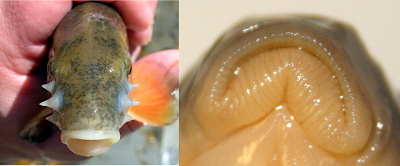The
Eastern Creek Chubsucker occurs throughout many of the Atlantic slope drainages
of the United States. It is typically
found in small streams and riverine wetlands, hence the “creek”
descriptor. It is very seldom caught by anglers because of
its small mouth and is also infrequently observed by fisheries biologists. Adults are olive-brown above grading to a
more golden color on the sides and a white or silvery belly. Fins are olive-gray and may be yellow at times. The scales
are darkly edged with pigments, which gives the fish a cross-hatched appearance
on the sides. The genus
name, Erimyzon, derives from the Greek
word eri meaning "very much" or "a lot," and myzo "to suck." The specific name, oblongus, refers to the oblong body shape, because it is longer than the
Lake Chubsucker. The Lake Chubsucker was
the “chubby” one, first described by the French naturalist, Bernard Germain de Lacépède in 1803.
 |
| Adult male Eastern Creek Chubsucker (top, photo by Jason Emmel) and juvenile (bottom) |
Eastern
Creek Chubsucker is a member of the sucker family (Catostomidae) and has a small, slightly oblique,
nearly terminal sucker-type mouth with fleshy plicate lips. It is a small sucker, generally less than 20
cm. The body is thick and round, hence the “chubby”
descriptor. During spawning the males are dark brown above
and pink to yellow below with orange paired fins and yellow median fins. Breeding males also develop 3 large tubercles
on each side of the snout. Young Eastern Creek Chubsuckers are
distinguished by a faint yellow stripe above black stripe that extends from the
snout to the caudal fin base.
 |
| Three large tubercles on snout of breeding male (left, photo by Todd Crail); Ventral view of mouth of Eastern Creek Chubsucker showing plicate lips, which meet at nearly right angles (right). |
The
genus, Erimyzon, consist of four
species, the Eastern Creek Chubsucker E. oblongus,
Western Creek Chubsucker C. claviformis,
Lake Chubsucker E. sucetta, and the Sharpfin
Chubsucker E. tenuis. Older literature recognizes two disjunct forms,
or subspecies of Creek Chubsuckers, one along the Atlantic slope drainages and
one in Mississippi and Gulf Slope drainages. However, today these are considered Eastern
Creek Chubsucker and Western Creek Chubsucker.
All members of the genus are similar in body shape and have no lateral
line. They are distinguishable by scale
counts. The lateral line is a system of sense organs
used to detect movement and vibrations in surrounding water, very useful adaptation. The loss of the lateral line is a derived trait but raises the question "Why lose a lateral line organ?" No one has ever investigated that
evolutionary question.
Creek
Chubsucker may be important pioneer fishes, among the first to ascend small creek
newly flowing in the springtime. Creek
Chubsuckers spawn in spring (March through May) over sand and gravel. The very large tubercles on the snout are
formidable looking weapons and one can only speculate about the nature of
agonistic encounters among breeding male Creek Chubsuckers. Larry Page and Carole Johnston do describe
males defending territories by head butting.
After males establish breeding territories, they court females and lead
them to the territory. The female digs in
the gravel with her snout presumable to indicate spawning readiness. To view these activities click here.
Although
the Eastern Creek Chubsucker is widely distributed, there have been few studies
that examine the role(s) that it plays in the aquatic ecosystem. Databases on fishes will categorize its
feeding mode as invertivore, but its feeding behavior and preferences in the
dynamic creeks and riverine wetlands are largely unexplored. Even Wikipedia has conflicting entries
regarding the invertivore and/or herbivore-detritivore classification. More research is needed on this
question! One study examined 16
specimens in a Virginia stream; of the 13 that had food materials, 61% contained
digested plant matter and animal food items were entomostracans (a subclass of
Crustaceans).
Some other observations provide hints to the
role of this species. During breeding, the scattering of thousands of eggs for
each spawning females attracts many egg predators. The mortality is likely very high and,
therefore, the Creek Chubsucker with its high fecundity likely feeds many carnivorous animals. The
Eastern Creek Chubsucker is often associated with warm-water, sluggish streams
that also support Brown Bullhead Ameiurus
nebulosus, Pumpkinseed Lepomis
gibbosus, Yellow Perch Perca flavesens, and either the Chain
Pickerel Esox niger or the Redfin
Pickerel Esox americanus. It is likely the Eastern Creek Chubsucker is a
frequently encountered prey item in the diet of the black bass and pickerels. Along
with Golden Shiner Notemigonus
crysoleucas and Fathead Minnow Pimephales promelas, chubsuckers are highly
acceptable baits for fishermen. In fact, many lure makers have patterned artificial
lures to resemble the chubsuckers.
The
unfortunate reality is that there are few studies that examine the status of
populations of the Eastern Creek Chubsucker or other species of chubsuckers
throughout their range. Milton
Trautman, author of “The Fishes of Ohio” described the detrimental effect of
heavy erosion on Western Creek Chubsucker. He wrote that “upon several occasions I found
many dead chubsuckers in a stream section whose water contained much clayey
silt. This silt had been washed into the
stream from recently cultivated cornfields during a brief summer shower. The sticky silt had packed about the gills of
the chubsuckers, suffocating them.” As far as I know there are no "Save the Chubsucker" associations anywhere. So keep a look out for these "chubby" suckers and see what they might be telling you.
References
Page,
L.M. and C.E. Johnston. 1990. Spawning in the Creek Chubsucker, Erimyzon oblongus, with a Review of
Spawning Behavior in Suckers (Catostomidae). Environmental Biology of Fishes 27:265-272
Trautman,
M.B. 1981. The fishes of Ohio. Ohio State Univ. Press, Columbus. 782 pp.
Wagner,
C.C. and E.L. Cooper.1963. Population density,
growth, and fecundity of the Creek Chubsucker, Erimyzon oblongus. Copeia 1963:350-357.




No comments:
Post a Comment